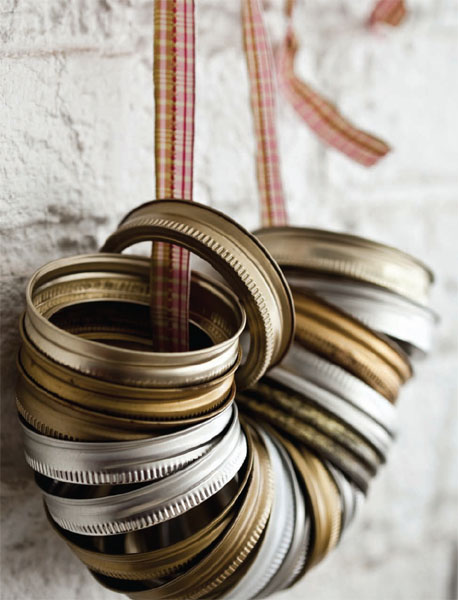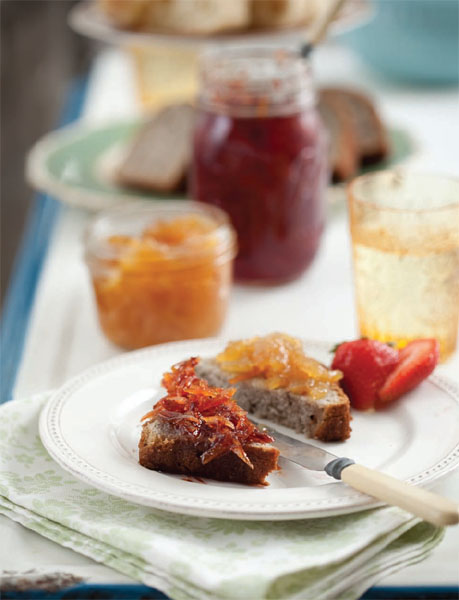Food in Jars (12 page)
Authors: Marisa McClellan
2½ cups/600 ml freshly squeezed Meyer lemon juice, seeds reserved (from about 20 lemons)
2 cups/400 g granulated sugar
Prepare a boiling water bath and 3 half-pint/250 ml jars according to the process on page 10. Place the lids in a small saucepan, cover them with water, and simmer over very low heat.
Place the reserved seeds in the center of a 6-inch/15 cm length of cheesecloth. Roll the cheesecloth up and tie it tightly so that no seeds are able to escape.
In a large, nonreactive pot, combine Meyer lemon juice, sugar, and the bundle of seeds.
Bring to a boil and cook over high heat for 15 to 25 minutes, stirring frequently, until the volume in the pot is greatly reduced. While you continue to stir, clip a candy thermometer to the pot and watch until it reaches 220°F/105°C. It should look thick and syrupy and the bubbles should look glossy.
Test the set of the jelly using the saucer test described on page 77. If it doesn't pass, return the pot to the heat and cook for an additional 5 minutes before repeating the test.
When the jelly has reached the desired consistency, pour it into the prepared jars. Wipe the rims, apply the lids and rings, and process in a boiling water bath for 10 minutes (see
page 11
).


CARA CARA ORANGE-GINGER MARMALADE

D
URING MY CHILDHOOD, I WAS NEVER MUCH FOR
marmalade. When it came to peanut butter sandwiches, my sister and I preferred the strawberry jam that came in a blue plastic tub with a white lid and handle, like a little bucket. My mom always had a stash of something homemade tucked in the back of the fridge for her toast, while my dad typically gravitated towards the squeeze bottle of honey.
The only person I knew who kept marmalade on his grocery list was my grandpa Sid. He preferred Smucker's and liked a fine layer on a piece of morning toast. On occasion, he'd offer me a bite, and I always found it displeasingly bitter and not nearly sweet enough for my young taste buds.
It wasn't until several years ago, while watching the movie
Gosford Park
, that I reconsidered marmalade. There's one scene, in the final third of the movie, in which Maggie Smith's character is having breakfast in her room with her lady's maid. She lifts a cut-glass lid from a preserves jar and complains bitterly when she discovers that the marmalade it contains was store-bought, as opposed to being homemade. That scene settled into the depths of my brain and took root, sending out shoots that said “homemade marmalade is always preferable to mass-produced.”
Eventually, I gave it a shot. My first attempts were crude, though not entirely unappealing. I liked it enough to keep trying. In the years since, I have made marmalade every late winter, counting on it as talisman against the January blues.
Because marmalade uses the entirety of the fruit, I like to make sure I use the best I can find. Choose backyard or organic fruit, and wash it well in warm, soapy water. Living in Philadelphia means that backyard fruit is a fantasy for me, but during the citrus season, I'll often invest in a box of handpicked, pesticide-free fruit from Texas, Florida, or California. Local Harvest (
localharvest.com
) is a really good resource for tracking down reliable, well-regarded citrus growers.
Marmalade making requires a few additional pieces of equipment that are rarely used in other fruit preserves. Before you get started, make sure you have a length of cheesecloth handy in which to bundle up the seeds and other pectin-rich bits of fruit. You can also use a large, stainless steel tea ball. Additionally, since these spreads are almost entirely made without the aid of commercial pectin, you'll need a good thermometer to track the temperature of the cooking marmalade. I like to use an old-fashioned candy thermometer. I used to have a fancy digital one, but the probe stopped working after I dropped the whole thing into a pot of boiling marmalade. The analog ones are far more resilient.
In addition to tracking the temperature, I also believe in using the saucer test when making marmalades. At the beginning of cooking, place two or three small saucers or plates in the freezer to chill. When your marmalade is at the end of its cooking time, dollop a small spoonful of jam onto the center of the frozen plate and return it to the freezer for one to two minutes. The goal is to speed up its natural cooling process and see what the finished set will be like.
The hope is that it will firm up quickly and form a “skin” across the top of the puddle that will wrinkle when gently nudged with a fingertip. That means it's done. However, if the jam doesn't wrinkle and maintains a more syrupy consistency after a few minutes on the cold plate, it needs more cooking.
Several of these recipes call for powdered pectin. I prefer it to liquid pectin when making marmalades and jellies, as it has the ability to set more firmly. That's not always a consistency you want with jam, but it's highly desirable with marmalades.

T
HIS IS A LOVELY JAM FOR CITRUS LOVERS. IT
doesn't force you to play favorites and shows off all those bright, punchy citrus flavors. In addition to its many normal applications, I like to use a couple of dollops while quickly sautéeing sliced chicken breast. Served over steamed brown rice and with a side of broccoli, it's my cheap (and healthier) version of Chinese orange chicken take-out.
4 pounds/1.8 kg assorted citrus fruit
(I like to use 3 pink grapefruit, 4 lemons, and 5 navel oranges)
6 cups/1.2 kg granulated sugar
Wash the fruit in warm, soapy water and dry thoroughly. Using a serrated-edge vegetable peeler, remove the zest from the fruit. Stack the zest strips in piles and chop into fine confetti. Combine the zest in a pot with 2 quarts/2 liters filtered water. Bring to a boil, reduce the heat to medium-high, and simmer for 25 to 30 minutes, until zest ribbons are tender.
While the zest cooks, “supreme” the fruit by cutting the white pith away from the fruit and cutting the fruit into segments between the membranes. Collect the fruit and any juices in a large bowl and remove the seeds as you go, setting them aside.
When all the fruit has been segmented out, bundle the seeds into a length of cheesecloth, tying the ends of the cloth securely so that no seeds can escape.
Drain the zest in a fine-mesh sieve, reserving the cooking liquid.
Prepare a boiling water bath and 4 regular-mouth 1-pint/500 ml jars according to the process on page 10. Place the lids in a small saucepan, cover them with water, and simmer over very low heat.
In a pot, combine the drained zest, segmented citrus fruit and juice, 4 cups/960 ml of the reserved cooking liquid, the sugar, and the cheesecloth bundle. Bring to a vigorous boil and cook until the mixture reaches 220°F/105°C (this takes between 30 and 40 minutes). Stir regularly as it cooks to prevent scorching.
When the marmalade reaches 220°F/105°C and sustains that temperature for 1 minute (even after stirring), remove the pot from the heat. Test the set of the marmalade
using the saucer test described on page 77. If it doesn't pass, return the pot to the heat and cook for an additional 5 minutes before repeating the test. Once it seems to be setting to your satisfaction, remove the pot from the heat and remove the cheesecloth bundle. Stir marmalade for about 1 minute, to help the zest bits become evenly distributed throughout the preserves.
Ladle the marmalade into the prepared jars. Wipe the rims, apply the lids and rings, and process in a boiling water bath for 10 minutes (see
page 11
).

W
HEN I WAS YOUNG, MY GRANDMA BUNNY LIVED
in an asymmetrical ranch house in Woodland Hills, California. It was perched on a hillside and the air around the house smelled like eucalyptus leaves, rosemary, and Meyer lemons. She was the proudest Meyer lemon mama you'd ever meet and enjoyed evangelizing their many virtues. Though I can't prove it, I think she may have been behind their renewed popularity. I'm certain Bunny would have loved this marmalade, because it manages to both capture and enhance the flavor of these bracing, thin-skinned orange-lemon hybrids. Because I can't bear to waste even a smidgen of a good Meyer, this is a marmalade recipe that uses the whole fruit. Because of this, it does need an overnight rest in the fridge before using, to help break down the white pith and render it a bit less bitter.